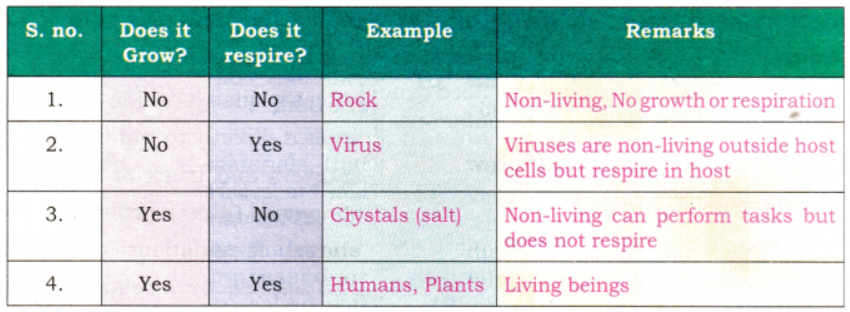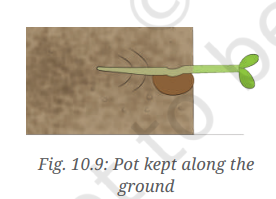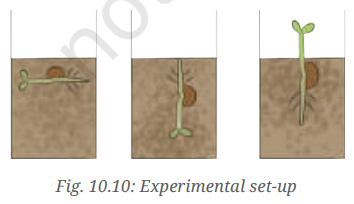Questions Ans For All Chapters – Science Curiosity Class 6
Living Creatures: Exploring their Characteristics
1. List the similarities and differences in life cycles of plants and animals.
Answer:
| Aspect | Plants | Animals | Similarities |
| Beginning of Life Cycle | Starts from a seed. | Starts from an egg/embryo or directly born. | Both begin life as a simple form (seed/egg). |
| Growth | Seed germination, root and shoot development. | Stages like embryo, infant, and adult. | Both grow and increase in size and complexity. |
| Stages of Life | Seed → Seedling → Mature Plant → Flower/Fruit → Seed. | Egg → Larva/Young → Adult. | Both have distinct stages of development. |
| End of Life Cycle | Death after fruiting or after a certain period of maturity. | Death after a certain lifespan, based on species. | Both life cycles end with death. |
2. The table on the next page shows some data. Study the dataand try to find out examples appropriate for the conditions given in the second and third columns. If you think that an example for any of the conditions given below is not possible, explain why.
Answer:
3. You have learnt that different conditions are required for seed germination. How can we use this knowledge for proper storage of grains and pulses?
Answer: Proper storage of grains and pulses requires controlling moisture levels since water is essential for germination. Keeping the grains dry and in airtight containers prevents germination and fungal growth.
4. You have learnt that a tail is present in a tadpole but it disappears as it grows into a frog. What is the advantage of having a tail in the tadpole stage?
Answer: The tail helps tadpoles swim efficiently in water, which is essential for finding food and escaping predators in their aquatic environment.
5. Charan says that a wooden log is non-living as it cannot move. Charu counters it by saying that it is living because it is made of wood obtained from trees. Give your arguments in favour or against the two statements given by Charan and Charu.
Answer:
Arguments for and against Charan and Charu’s statements:
Charan’s Argument: A wooden log is non-living because it cannot perform essential characteristics of living things like movement, growth, respiration, and reproduction.
Charu’s Argument: While the wood comes from a tree that was once living, the log itself is no longer alive as it does not exhibit the characteristics of living beings, like growth and respiration, anymore.
6. What are the similarities and distinguishing features in the life cycles of a mosquito and a frog?
Answer:
- frog – Egg → Tadpole → Froglet → Adult
- mosquito – Egg → Larva → Pupa → Adult
Similarities:
- Both go through stages of metamorphosis involving eggs, larval stages, and adult forms.
- Significant changes in body shape and structure occur during their life cycles.
Differences:
- Mosquito larvae live in water but develop into flying adults, while frog tadpoles live in water but become land-dwelling adult frogs.
- Mosquito larvae and pupae require stagnant water, while frogs can live in more varied water bodies and spend part of their lives on land.
7. A plant is provided with all the conditions suitable for its growth (Fig. below). Draw what you expect to see in the shoot and the root of the plant after one week. Write down the reasons.
Answer:
The shoot will grow upward, and the roots will grow downward into the soil. The plant will show phototropism, where the shoot grows towards light and the roots exhibit geotropism, growing towards gravity.
8. Tara and Vijay set up the experiment’ shown in the picture (Fig. below). What do you think they want to find out? How will they know if they are correct?
Answer:
Purpose of Tara and Vijay’s experiment:
They likely want to test how different environmental factors like light or water availability affect plant growth. They will know if they are correct by observing the differences in growth patterns in the plants subjected to different conditions.
Observation: If the shoot always grows upwards (towards the light) and the root always grows downwards (into the soil), regardless of how the seed is placed, this shows that plants have natural mechanisms (like phototropism and gravitropism) that guide their growth direction.
9. Design an experiment to check if temperature has an effect on seed germination.
Answer:
Take several pots, each containing the same type of seeds and soil. Keep the pots at different temperatures (e.g., in a warm room, cold room, and at room temperature). Monitor and record the germination rate in each condition to check how temperature influences seed sprouting.
Observation: Measure and compare the rate of germination and growth in different temperatures.
Conclusion: Determine the optimal temperature for seed germination based on observations.





Feeling great! The exam was easy 👍🏻
Nice
😊😊
Nice but big more Qla 😊😊
It’s is good but answer is too long😊😊
I like this thing I passed my exam thank you very much
Latika here. Very helpful and I could pass my exam thank you evidyarthi
It’s so good by this I passed my exam